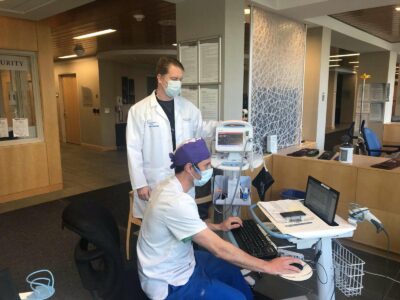Dr. James Dwyer, Chair of Emergency Medicine at Northern Westchester Hospital (NWH), discussed the alarming decline in visits to the ER among patients with serious, life-threatening medical conditions, including heart attacks, strokes, and appendicitis.
“We are seeing similar scenarios over and over again,” said Dr. Dwyer in an interview this week. “A patient, for example, who has abdominal pain is afraid to come into the Emergency Department, so they tough it out and think: ‘it will go away, it will go away..,’ and then by the time they realize it won’t, they come in with a ruptured appendix as opposed to catching the appendicitis before it’s ruptured and getting to the operating room earlier.”

Photo courtesy of NWH
According to Dr. Dwyer, ERs around the country are seeing a drop in overall patient volume due to patient fears about COVID-19. As a result, untold numbers of people may be dying at home or risking long-term health consequences by ignoring serious symptoms.
Meanwhile, “when appendicitis (removal of the appendix) is performed as a routine procedure, the outcomes are outstanding; most of the people are out the same day,” said Dwyer. In contrast, a life-threatening rupture can spread infection in the abdomen requiring more involved surgery and longer recovery times.
Since the pandemic started March 11, about 50% of the appendicitis cases have presented as ruptured–a normal scenario is 5-10 percent,” he elaborated. “1 in 2 ruptured versus 1 in 10… people are definitely waiting to get this taken care of.”
NWH is seeing about a 50 percent drop to their usual ER volume, Dr. Dwyer said. At NWH, the ER typically sees more than 80 patients per day and is now seeing as few as 30. “The decline in ER visits among people with serious, life-threatening conditions, including heart attacks, strokes, infections and trauma, is taking a toll on the health and wellbeing of people in the United States and around the world.
Dr. Dwyer said some patients experiencing symptoms may not be calling their doctors because they are afraid their doctors will tell them to go to the Emergency Department. “It’s possible not enough people experiencing symptoms are reaching out to their primary doctors,” he said adding that the many excellent practitioners in the area could properly discern symptoms and steer patients to the ER, as needed.
“I saw a patient who had been short of breath for six days before he decided to see his primary doctor; when he finally saw him, he found a very rapid heart rhythm, an atrial fibrillation. We immediately admitted him to the hospital.”
“We need people to understand that it is safe to go to the ER, and far more dangerous to stay home and wait for serious symptoms to disappear.”
Before coronavirus, 12% (just over one in 10) people with stroke symptoms waited one day before visiting the ER; now, 25% (one in four) wait at least one day, despite symptoms that can include loss of vision, speech, sensations and weakness on one side.
Surviving stroke, he explained, is very time dependent. “For those who present early– within 4.5 hours–we can give medication that breaks up the clot. The window for treating more severe stroke–via an endovascular procedure to open up the blood vessel–is traditionally within six hours, and in a small minority of cases, up to 24 hours.”
“The earlier you get these therapies, the more successful they are at preventing a bad outcome,” he said.
“We want people to know that it’s safe to visit the ER,” he emphasized. “At NWH, people are screened at the front door of the Emergency Department, everyone in the entire institution wears a mask, and patients are treated in private rooms.”
Dr. Dwyer added: “The precautions we take here are working. Very few staff members have been diagnosed with COVID since this started.” Dr. Dwyer also pointed out that only a small number of visitors are allowed in the hospital so as to protect overall populations. These include partners of women giving birth, parents to a pediatric patient, and close family members to those dying of COVID-19 or any other condition.
As of this morning (May 13), NWH was caring for 19 COVID-positive patients in the hospital, which is significantly down,” Dr. Dwyer said. “We were up in the 80s at the beginning of April, so it has come down quite a bit. We still have 10 people on ventilators who are COVID positive. Some of these critically ill people require an extended period of time for their lungs to recover on the ventilator.”
“We happen to have had some success treating patients on ventilators. The 10,000th discharge from Northwell in fact was from Northern Westchester Hospital, someone who was severely infected who is now recovering.”
“From our institution alone, we have had 247 live covid discharges. That’s very encouraging.” There have been 58 COVID-related mortalities.
Dr. Dwyer elaborated: “We have worked very, very hard to make sure this is a safe environment, and in the ER, especially. When you come into the ER, you are screened at the door, and given a surgical mask and then escorted to one of 26 private rooms–there is very little chance of being exposed to COVID at NWH.
He pointed out that his nine-year-old nephew was a patient recently. “He had a laceration. He had cut his ear on a branch outside running around–he came into the ER, and one of the nurse practitioners sewed his ear up. I feel comfortable having my own family here.”
Dr. Dwyer urges people to recognize the signs and symptoms of the following life- threatening conditions:
Heart attack
People who survive a heart attack may have weakened heart muscles and are at risk for life-threatening complications including another more serious heart attack. Go to the ER immediately if you have any of the following symptoms:
- Chest pain, including tightness, and pain that spreads to the arms, neck, jaw or back;
- Sudden onset of shortness of breath, sweating, dizziness or lightheadedness;
- Unexplained nausea, indigestion, or heartburn.
Strokes
When caught early, immediate treatment may prevent death and minimize the long-term effects of a stroke. Even if a stroke is minor, it is important to receive an evaluation and treatment in order to prevent another, possibly devastating, stroke: Go to the ER immediately if you have any of the following symptoms:
- Body weakness, especially on one side;
- Facial droop;
- Difficulty speaking or finding words;
- Sudden loss of vision;
- Numbness or loss of sensation;
- Unsteadiness on your feet.
Appendicitis
When caught early, a surgeon can remove the appendix and often send you home the same day. If the appendix ruptures, a patient will spend days in the hospital and be at risk of life-threatening conditions that include peritonitis and sepsis. Go to the ER if you have the following symptoms:
- Pain in the right lower quadrant of the abdomen (which typically increases when you move and intensifies over 24 to 48 hours), sometimes with
- Loss of appetite;
- Nausea and vomiting;
- Fever.


